Session 43
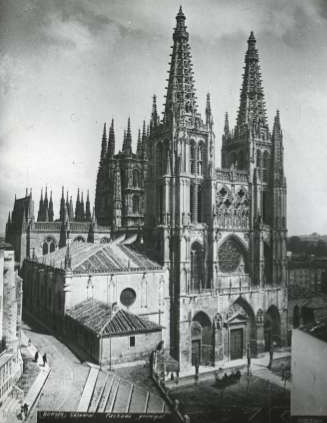
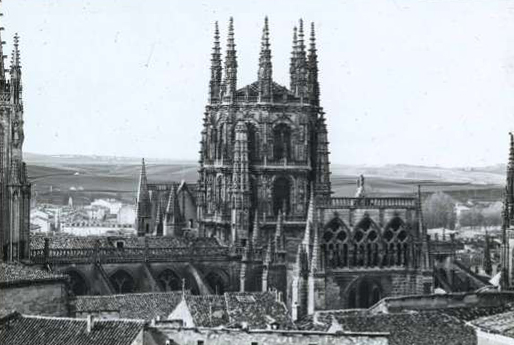
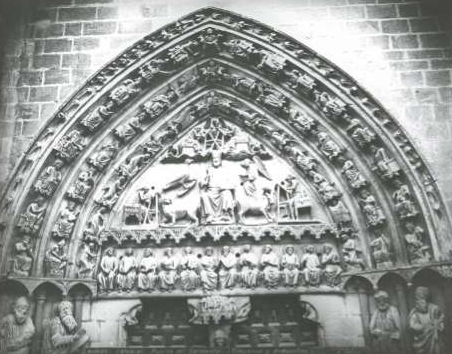
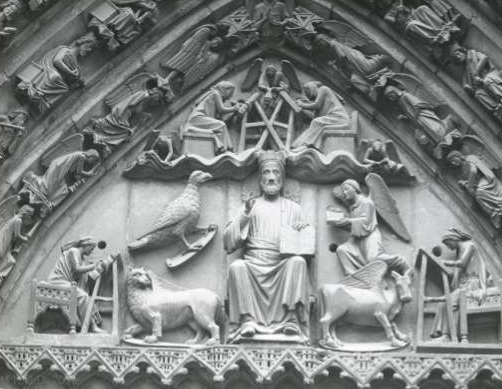

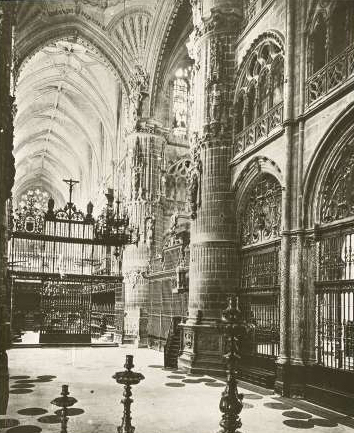
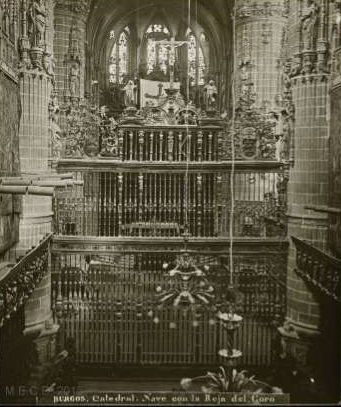
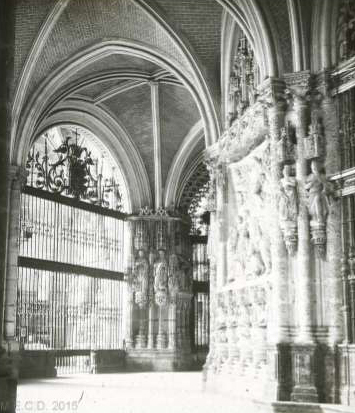
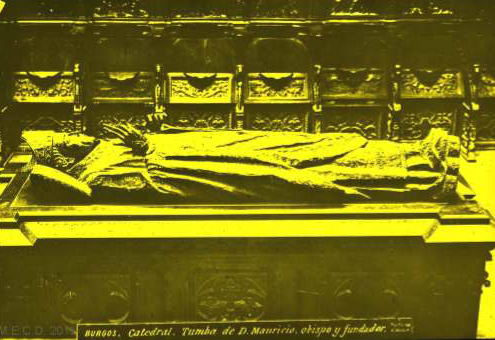
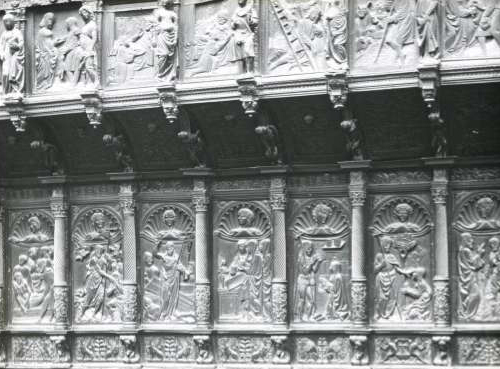
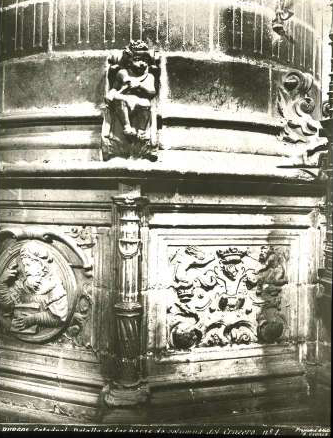
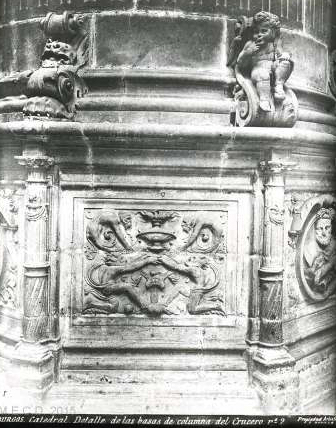
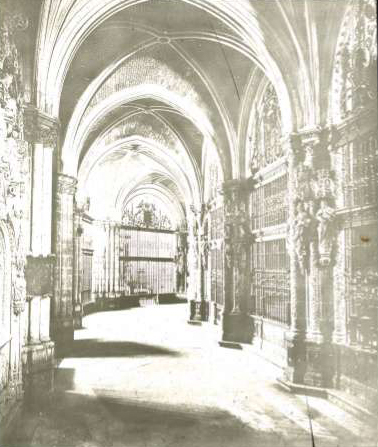
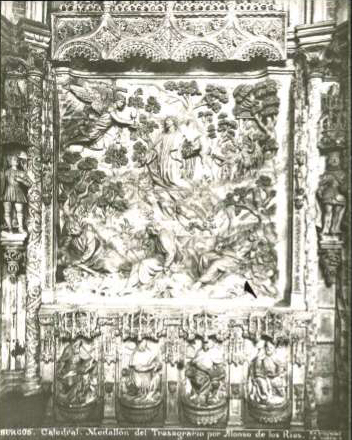
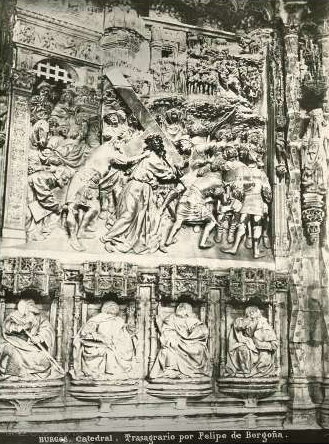
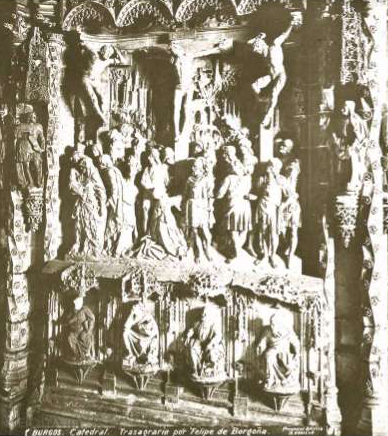
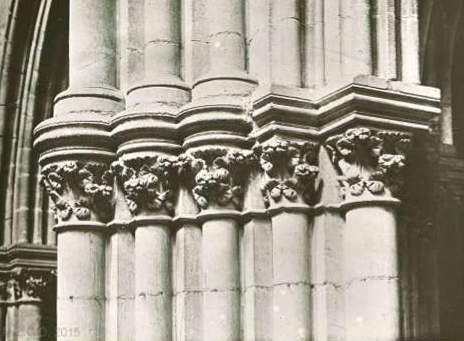
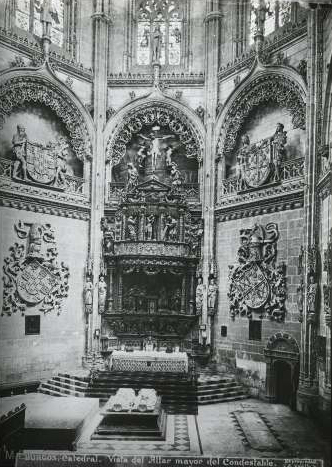
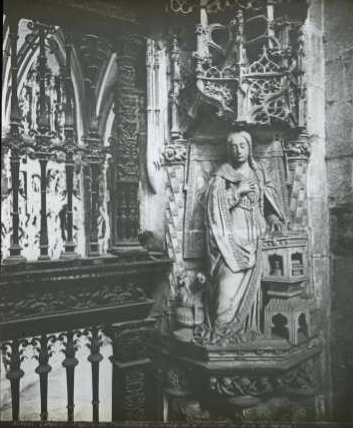
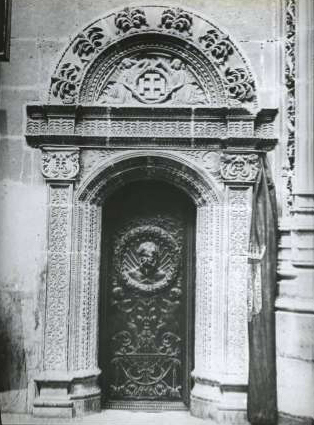

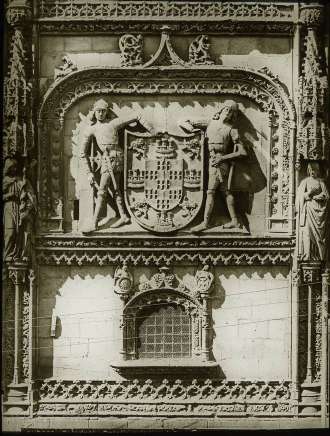
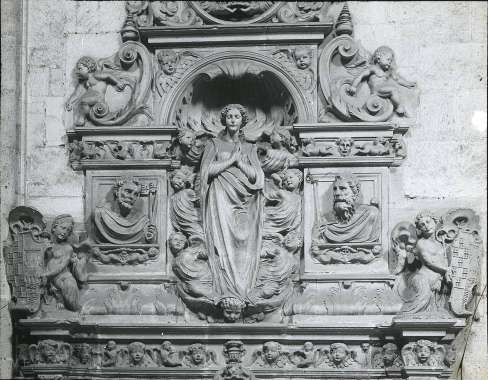
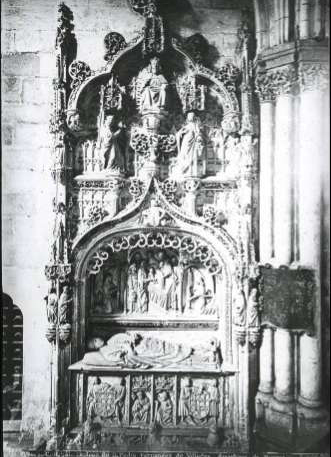
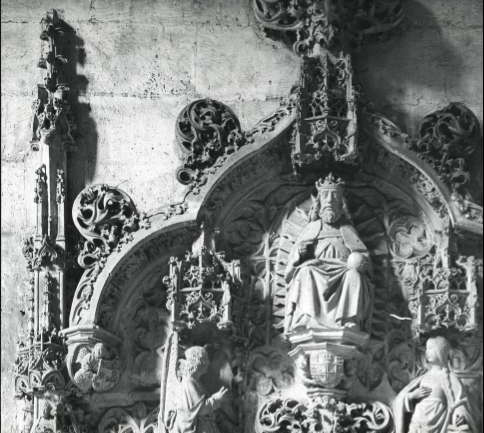
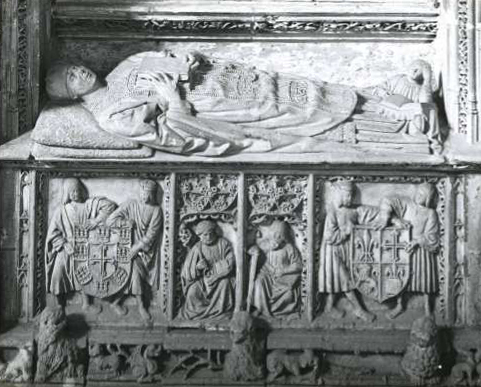


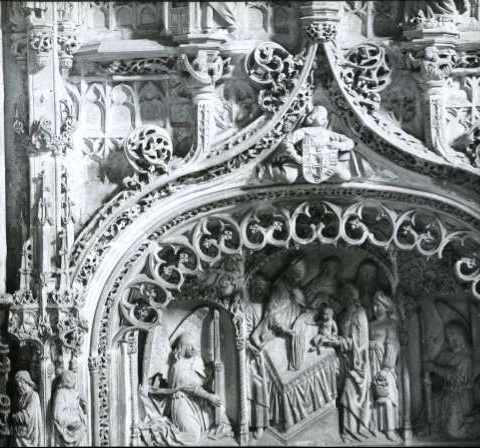
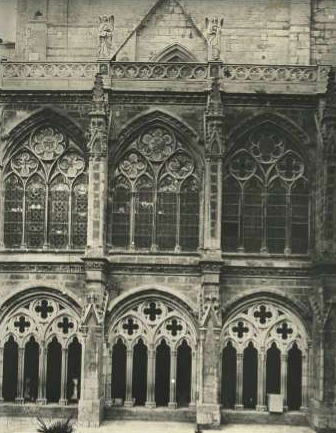
- 1. Fachada principal
- 2. Vista parcial de la Catedral
- 3. Puerta del Sarmental. Tímpano y archivoltas
- 4. Puerta del Sarmental. Tímpano. Detalle n. 1
- 5. Puerta del Sarmental. Detalle de las archivoltas n. 2
- 6. Nave de la Capilla Mayor
- 7. Reja del Coro
- 8. Nave del Evangelio
- 9. Tumba del Obispo D. Mauricio, fundador
- 10. Detalle de la Sillería del Coro
- 11. Basas del crucero n. 1
- 12. Detalle de las basas de columna del crucero
- 13. Nave del trasagrario
- 14. Medallón del trasagrario. Oración del Huerto
- 15. Medallón del trasagrario por Felipe de Borgoña
- 16. Medallón del trasagrario por Felipe de Borgoña
- 17. Detalle de Capiteles del Trascoro n. 2
- 18. Retablo mayor de la capilla de los Condestables de Castilla
- 19. Capilla del Condestable. Jamba en el interior del arco de ingreso
- 20. Detalle Altar Mayor
- 21. Capilla del Condestable. Puerta de la Sacristía
- 22. Capilla del Condestable. Detalle exterior n. 1
- 23. Capilla del Condestable. Detalle exterior n. 2
- 24. Capilla de Santiago. Sepulcro del canónigo Juan Ortega. Detalle n.2
- 25. Sepulcro de D. Pedro Fernández Villegas. Primer traductor de Dante
- 26. Sepulcro del Arcediano Pedro F. de Villegas. Detalle n.1
- 27. Sepulcro del Arcediano Pedro F. Villegas. Detalle n. 3
- 28. Capilla de Santa Ana. Detalle Retablo
- 29. Claustro. Estatuas de los cuatro hijos de San Fernando
- 30. Sepulcro del Arcediano Pedro F. Villegas. Detalle n. 2
1. Fachada principal
- Registration number BVPB20160767889-01
- Collection title Burgos_catedral
- Collection's origin IES San Isidro
- Country of origin France
- Manufatured by Mazo Éditeur
- Year 1900-1925
- Dimensions 8,5 x 10 cm
- Genre Artistic
Theme
Artistic
Description
Magic lantern slides catalogued within the artistic genre refer to the visual dissemination of cultural content of Science and the Fine Arts. The term ‘Fine Arts’ became popular in the eighteenth century to refer to the forms of art that developed mainly through aesthetic philosophy, the idealization of beauty and the good use of technology. The first book known to classify the fine arts is Les Beaux-Arts réduits à un même principe (The Fine Arts Reduced to a Single Principle), published in 1746 by Frenchman Charles Batteux, who tried to unify the numerous theories about beauty and liking. Batteux originally included in the Fine Arts: dancing, sculpturing, music, painting, and poetry, though he added later architecture and eloquence. Over time, the list would change according to different authors that added or removed arts to this list: first, eloquence was substracted, and, in 1911, Ricciotto Canudo was the first theorist to qualify cinema as the seventh art in his essay Manifiesto de las siete artes, which was published in 1914. Also, for the historical evolution of the term, it is common for it to be associated —especially in educational institutions and museums— almost exclusively to the plastic or visual arts.
2. Vista parcial de la Catedral
- Registration number BVPB20160767889-02
- Collection title Burgos_catedral
- Collection's origin IES San Isidro
- Country of origin France
- Manufatured by Mazo Éditeur
- Year 1900-1925
- Dimensions 8,5 x 10 cm
- Genre Artistic
Theme
Artistic
Description
Magic lantern slides catalogued within the artistic genre refer to the visual dissemination of cultural content of Science and the Fine Arts. The term ‘Fine Arts’ became popular in the eighteenth century to refer to the forms of art that developed mainly through aesthetic philosophy, the idealization of beauty and the good use of technology. The first book known to classify the fine arts is Les Beaux-Arts réduits à un même principe (The Fine Arts Reduced to a Single Principle), published in 1746 by Frenchman Charles Batteux, who tried to unify the numerous theories about beauty and liking. Batteux originally included in the Fine Arts: dancing, sculpturing, music, painting, and poetry, though he added later architecture and eloquence. Over time, the list would change according to different authors that added or removed arts to this list: first, eloquence was substracted, and, in 1911, Ricciotto Canudo was the first theorist to qualify cinema as the seventh art in his essay Manifiesto de las siete artes, which was published in 1914. Also, for the historical evolution of the term, it is common for it to be associated —especially in educational institutions and museums— almost exclusively to the plastic or visual arts.
3. Puerta del Sarmental. Tímpano y archivoltas
- Registration number BVPB20160767889-03
- Collection title Burgos_catedral
- Collection's origin IES San Isidro
- Country of origin France
- Manufatured by Mazo Éditeur
- Year 1900-1925
- Dimensions 8,5 x 10 cm
- Genre Artistic
Theme
Artistic
Description
Magic lantern slides catalogued within the artistic genre refer to the visual dissemination of cultural content of Science and the Fine Arts. The term ‘Fine Arts’ became popular in the eighteenth century to refer to the forms of art that developed mainly through aesthetic philosophy, the idealization of beauty and the good use of technology. The first book known to classify the fine arts is Les Beaux-Arts réduits à un même principe (The Fine Arts Reduced to a Single Principle), published in 1746 by Frenchman Charles Batteux, who tried to unify the numerous theories about beauty and liking. Batteux originally included in the Fine Arts: dancing, sculpturing, music, painting, and poetry, though he added later architecture and eloquence. Over time, the list would change according to different authors that added or removed arts to this list: first, eloquence was substracted, and, in 1911, Ricciotto Canudo was the first theorist to qualify cinema as the seventh art in his essay Manifiesto de las siete artes, which was published in 1914. Also, for the historical evolution of the term, it is common for it to be associated —especially in educational institutions and museums— almost exclusively to the plastic or visual arts.
4. Puerta del Sarmental. Tímpano. Detalle n. 1
- Registration number BVPB20160767889-04
- Collection title Burgos_catedral
- Collection's origin IES San Isidro
- Country of origin France
- Manufatured by Mazo Éditeur
- Year 1900-1925
- Dimensions 8,5 x 10 cm
- Genre Artistic
Theme
Artistic
Description
Magic lantern slides catalogued within the artistic genre refer to the visual dissemination of cultural content of Science and the Fine Arts. The term ‘Fine Arts’ became popular in the eighteenth century to refer to the forms of art that developed mainly through aesthetic philosophy, the idealization of beauty and the good use of technology. The first book known to classify the fine arts is Les Beaux-Arts réduits à un même principe (The Fine Arts Reduced to a Single Principle), published in 1746 by Frenchman Charles Batteux, who tried to unify the numerous theories about beauty and liking. Batteux originally included in the Fine Arts: dancing, sculpturing, music, painting, and poetry, though he added later architecture and eloquence. Over time, the list would change according to different authors that added or removed arts to this list: first, eloquence was substracted, and, in 1911, Ricciotto Canudo was the first theorist to qualify cinema as the seventh art in his essay Manifiesto de las siete artes, which was published in 1914. Also, for the historical evolution of the term, it is common for it to be associated —especially in educational institutions and museums— almost exclusively to the plastic or visual arts.
5. Puerta del Sarmental. Detalle de las archivoltas n. 2
- Registration number BVPB20160767889-05
- Collection title Burgos_catedral
- Collection's origin IES San Isidro
- Country of origin France
- Manufatured by Mazo Éditeur
- Year 1900-1925
- Dimensions 8,5 x 10 cm
- Genre Artistic
Theme
Artistic
Description
Magic lantern slides catalogued within the artistic genre refer to the visual dissemination of cultural content of Science and the Fine Arts. The term ‘Fine Arts’ became popular in the eighteenth century to refer to the forms of art that developed mainly through aesthetic philosophy, the idealization of beauty and the good use of technology. The first book known to classify the fine arts is Les Beaux-Arts réduits à un même principe (The Fine Arts Reduced to a Single Principle), published in 1746 by Frenchman Charles Batteux, who tried to unify the numerous theories about beauty and liking. Batteux originally included in the Fine Arts: dancing, sculpturing, music, painting, and poetry, though he added later architecture and eloquence. Over time, the list would change according to different authors that added or removed arts to this list: first, eloquence was substracted, and, in 1911, Ricciotto Canudo was the first theorist to qualify cinema as the seventh art in his essay Manifiesto de las siete artes, which was published in 1914. Also, for the historical evolution of the term, it is common for it to be associated —especially in educational institutions and museums— almost exclusively to the plastic or visual arts.
6. Nave de la Capilla Mayor
- Registration number BVPB20160767889-06
- Collection title Burgos_catedral
- Collection's origin IES San Isidro
- Country of origin France
- Manufatured by Mazo Éditeur
- Year 1900-1925
- Dimensions 8,5 x 10 cm
- Genre Artistic
Theme
Artistic
Description
Magic lantern slides catalogued within the artistic genre refer to the visual dissemination of cultural content of Science and the Fine Arts. The term ‘Fine Arts’ became popular in the eighteenth century to refer to the forms of art that developed mainly through aesthetic philosophy, the idealization of beauty and the good use of technology. The first book known to classify the fine arts is Les Beaux-Arts réduits à un même principe (The Fine Arts Reduced to a Single Principle), published in 1746 by Frenchman Charles Batteux, who tried to unify the numerous theories about beauty and liking. Batteux originally included in the Fine Arts: dancing, sculpturing, music, painting, and poetry, though he added later architecture and eloquence. Over time, the list would change according to different authors that added or removed arts to this list: first, eloquence was substracted, and, in 1911, Ricciotto Canudo was the first theorist to qualify cinema as the seventh art in his essay Manifiesto de las siete artes, which was published in 1914. Also, for the historical evolution of the term, it is common for it to be associated —especially in educational institutions and museums— almost exclusively to the plastic or visual arts.
7. Reja del Coro
- Registration number BVPB20160767889-07
- Collection title Burgos_catedral
- Collection's origin IES San Isidro
- Country of origin France
- Manufatured by Mazo Éditeur
- Year 1900-1925
- Dimensions 8,5 x 10 cm
- Genre Artistic
Theme
Artistic
Description
Magic lantern slides catalogued within the artistic genre refer to the visual dissemination of cultural content of Science and the Fine Arts. The term ‘Fine Arts’ became popular in the eighteenth century to refer to the forms of art that developed mainly through aesthetic philosophy, the idealization of beauty and the good use of technology. The first book known to classify the fine arts is Les Beaux-Arts réduits à un même principe (The Fine Arts Reduced to a Single Principle), published in 1746 by Frenchman Charles Batteux, who tried to unify the numerous theories about beauty and liking. Batteux originally included in the Fine Arts: dancing, sculpturing, music, painting, and poetry, though he added later architecture and eloquence. Over time, the list would change according to different authors that added or removed arts to this list: first, eloquence was substracted, and, in 1911, Ricciotto Canudo was the first theorist to qualify cinema as the seventh art in his essay Manifiesto de las siete artes, which was published in 1914. Also, for the historical evolution of the term, it is common for it to be associated —especially in educational institutions and museums— almost exclusively to the plastic or visual arts.
8. Nave del Evangelio
- Registration number BVPB20160767889-08
- Collection title Burgos_catedral
- Collection's origin IES San Isidro
- Country of origin France
- Manufatured by Mazo Éditeur
- Year 1900-1925
- Dimensions 8,5 x 10 cm
- Genre Artistic
Theme
Artistic
Description
Magic lantern slides catalogued within the artistic genre refer to the visual dissemination of cultural content of Science and the Fine Arts. The term ‘Fine Arts’ became popular in the eighteenth century to refer to the forms of art that developed mainly through aesthetic philosophy, the idealization of beauty and the good use of technology. The first book known to classify the fine arts is Les Beaux-Arts réduits à un même principe (The Fine Arts Reduced to a Single Principle), published in 1746 by Frenchman Charles Batteux, who tried to unify the numerous theories about beauty and liking. Batteux originally included in the Fine Arts: dancing, sculpturing, music, painting, and poetry, though he added later architecture and eloquence. Over time, the list would change according to different authors that added or removed arts to this list: first, eloquence was substracted, and, in 1911, Ricciotto Canudo was the first theorist to qualify cinema as the seventh art in his essay Manifiesto de las siete artes, which was published in 1914. Also, for the historical evolution of the term, it is common for it to be associated —especially in educational institutions and museums— almost exclusively to the plastic or visual arts.
9. Tumba del Obispo D. Mauricio, fundador
- Registration number BVPB20160767889-09
- Collection title Burgos_catedral
- Collection's origin IES San Isidro
- Country of origin France
- Manufatured by Mazo Éditeur
- Year 1900-1925
- Dimensions 8,5 x 10 cm
- Genre Artistic
Theme
Artistic
Description
Magic lantern slides catalogued within the artistic genre refer to the visual dissemination of cultural content of Science and the Fine Arts. The term ‘Fine Arts’ became popular in the eighteenth century to refer to the forms of art that developed mainly through aesthetic philosophy, the idealization of beauty and the good use of technology. The first book known to classify the fine arts is Les Beaux-Arts réduits à un même principe (The Fine Arts Reduced to a Single Principle), published in 1746 by Frenchman Charles Batteux, who tried to unify the numerous theories about beauty and liking. Batteux originally included in the Fine Arts: dancing, sculpturing, music, painting, and poetry, though he added later architecture and eloquence. Over time, the list would change according to different authors that added or removed arts to this list: first, eloquence was substracted, and, in 1911, Ricciotto Canudo was the first theorist to qualify cinema as the seventh art in his essay Manifiesto de las siete artes, which was published in 1914. Also, for the historical evolution of the term, it is common for it to be associated —especially in educational institutions and museums— almost exclusively to the plastic or visual arts.
10. Detalle de la Sillería del Coro
- Registration number BVPB20160767889-10
- Collection title Burgos_catedral
- Collection's origin IES San Isidro
- Country of origin France
- Manufatured by Mazo Éditeur
- Year 1900-1925
- Dimensions 8,5 x 10 cm
- Genre Artistic
Theme
Artistic
Description
Magic lantern slides catalogued within the artistic genre refer to the visual dissemination of cultural content of Science and the Fine Arts. The term ‘Fine Arts’ became popular in the eighteenth century to refer to the forms of art that developed mainly through aesthetic philosophy, the idealization of beauty and the good use of technology. The first book known to classify the fine arts is Les Beaux-Arts réduits à un même principe (The Fine Arts Reduced to a Single Principle), published in 1746 by Frenchman Charles Batteux, who tried to unify the numerous theories about beauty and liking. Batteux originally included in the Fine Arts: dancing, sculpturing, music, painting, and poetry, though he added later architecture and eloquence. Over time, the list would change according to different authors that added or removed arts to this list: first, eloquence was substracted, and, in 1911, Ricciotto Canudo was the first theorist to qualify cinema as the seventh art in his essay Manifiesto de las siete artes, which was published in 1914. Also, for the historical evolution of the term, it is common for it to be associated —especially in educational institutions and museums— almost exclusively to the plastic or visual arts.
11. Basas del crucero n. 1
- Registration number BVPB20160767889-11
- Collection title Burgos_catedral
- Collection's origin IES San Isidro
- Country of origin France
- Manufatured by Mazo Éditeur
- Year 1900-1925
- Dimensions 8,5 x 10 cm
- Genre Artistic
Theme
Artistic
Description
Magic lantern slides catalogued within the artistic genre refer to the visual dissemination of cultural content of Science and the Fine Arts. The term ‘Fine Arts’ became popular in the eighteenth century to refer to the forms of art that developed mainly through aesthetic philosophy, the idealization of beauty and the good use of technology. The first book known to classify the fine arts is Les Beaux-Arts réduits à un même principe (The Fine Arts Reduced to a Single Principle), published in 1746 by Frenchman Charles Batteux, who tried to unify the numerous theories about beauty and liking. Batteux originally included in the Fine Arts: dancing, sculpturing, music, painting, and poetry, though he added later architecture and eloquence. Over time, the list would change according to different authors that added or removed arts to this list: first, eloquence was substracted, and, in 1911, Ricciotto Canudo was the first theorist to qualify cinema as the seventh art in his essay Manifiesto de las siete artes, which was published in 1914. Also, for the historical evolution of the term, it is common for it to be associated —especially in educational institutions and museums— almost exclusively to the plastic or visual arts.
12. Detalle de las basas de columna del crucero
- Registration number BVPB20160767889-12
- Collection title Burgos_catedral
- Collection's origin IES San Isidro
- Country of origin France
- Manufatured by Mazo Éditeur
- Year 1900-1925
- Dimensions 8,5 x 10 cm
- Genre Artistic
Theme
Artistic
Description
Magic lantern slides catalogued within the artistic genre refer to the visual dissemination of cultural content of Science and the Fine Arts. The term ‘Fine Arts’ became popular in the eighteenth century to refer to the forms of art that developed mainly through aesthetic philosophy, the idealization of beauty and the good use of technology. The first book known to classify the fine arts is Les Beaux-Arts réduits à un même principe (The Fine Arts Reduced to a Single Principle), published in 1746 by Frenchman Charles Batteux, who tried to unify the numerous theories about beauty and liking. Batteux originally included in the Fine Arts: dancing, sculpturing, music, painting, and poetry, though he added later architecture and eloquence. Over time, the list would change according to different authors that added or removed arts to this list: first, eloquence was substracted, and, in 1911, Ricciotto Canudo was the first theorist to qualify cinema as the seventh art in his essay Manifiesto de las siete artes, which was published in 1914. Also, for the historical evolution of the term, it is common for it to be associated —especially in educational institutions and museums— almost exclusively to the plastic or visual arts.
13. Nave del trasagrario
- Registration number BVPB20160767889-13
- Collection title Burgos_catedral
- Collection's origin IES San Isidro
- Country of origin France
- Manufatured by Mazo Éditeur
- Year 1900-1925
- Dimensions 8,5 x 10 cm
- Genre Artistic
Theme
Artistic
Description
Magic lantern slides catalogued within the artistic genre refer to the visual dissemination of cultural content of Science and the Fine Arts. The term ‘Fine Arts’ became popular in the eighteenth century to refer to the forms of art that developed mainly through aesthetic philosophy, the idealization of beauty and the good use of technology. The first book known to classify the fine arts is Les Beaux-Arts réduits à un même principe (The Fine Arts Reduced to a Single Principle), published in 1746 by Frenchman Charles Batteux, who tried to unify the numerous theories about beauty and liking. Batteux originally included in the Fine Arts: dancing, sculpturing, music, painting, and poetry, though he added later architecture and eloquence. Over time, the list would change according to different authors that added or removed arts to this list: first, eloquence was substracted, and, in 1911, Ricciotto Canudo was the first theorist to qualify cinema as the seventh art in his essay Manifiesto de las siete artes, which was published in 1914. Also, for the historical evolution of the term, it is common for it to be associated —especially in educational institutions and museums— almost exclusively to the plastic or visual arts.
14. Medallón del trasagrario. Oración del Huerto
- Registration number BVPB20160767889-14
- Collection title Burgos_catedral
- Collection's origin IES San Isidro
- Country of origin France
- Manufatured by Mazo Éditeur
- Year 1900-1925
- Dimensions 8,5 x 10 cm
- Genre Artistic
Theme
Artistic
Description
Magic lantern slides catalogued within the artistic genre refer to the visual dissemination of cultural content of Science and the Fine Arts. The term ‘Fine Arts’ became popular in the eighteenth century to refer to the forms of art that developed mainly through aesthetic philosophy, the idealization of beauty and the good use of technology. The first book known to classify the fine arts is Les Beaux-Arts réduits à un même principe (The Fine Arts Reduced to a Single Principle), published in 1746 by Frenchman Charles Batteux, who tried to unify the numerous theories about beauty and liking. Batteux originally included in the Fine Arts: dancing, sculpturing, music, painting, and poetry, though he added later architecture and eloquence. Over time, the list would change according to different authors that added or removed arts to this list: first, eloquence was substracted, and, in 1911, Ricciotto Canudo was the first theorist to qualify cinema as the seventh art in his essay Manifiesto de las siete artes, which was published in 1914. Also, for the historical evolution of the term, it is common for it to be associated —especially in educational institutions and museums— almost exclusively to the plastic or visual arts.
15. Medallón del trasagrario por Felipe de Borgoña
- Registration number BVPB20160767889-15
- Collection title Burgos_catedral
- Collection's origin IES San Isidro
- Country of origin France
- Manufatured by Mazo Éditeur
- Year 1900-1925
- Dimensions 8,5 x 10 cm
- Genre Artistic
Theme
Artistic
Description
Magic lantern slides catalogued within the artistic genre refer to the visual dissemination of cultural content of Science and the Fine Arts. The term ‘Fine Arts’ became popular in the eighteenth century to refer to the forms of art that developed mainly through aesthetic philosophy, the idealization of beauty and the good use of technology. The first book known to classify the fine arts is Les Beaux-Arts réduits à un même principe (The Fine Arts Reduced to a Single Principle), published in 1746 by Frenchman Charles Batteux, who tried to unify the numerous theories about beauty and liking. Batteux originally included in the Fine Arts: dancing, sculpturing, music, painting, and poetry, though he added later architecture and eloquence. Over time, the list would change according to different authors that added or removed arts to this list: first, eloquence was substracted, and, in 1911, Ricciotto Canudo was the first theorist to qualify cinema as the seventh art in his essay Manifiesto de las siete artes, which was published in 1914. Also, for the historical evolution of the term, it is common for it to be associated —especially in educational institutions and museums— almost exclusively to the plastic or visual arts.
16. Medallón del trasagrario por Felipe de Borgoña
- Registration number BVPB20160767889-16
- Collection title Burgos_catedral
- Collection's origin IES San Isidro
- Country of origin France
- Manufatured by Mazo Éditeur
- Year 1900-1925
- Dimensions 8,5 x 10 cm
- Genre Artistic
Theme
Artistic
Description
Magic lantern slides catalogued within the artistic genre refer to the visual dissemination of cultural content of Science and the Fine Arts. The term ‘Fine Arts’ became popular in the eighteenth century to refer to the forms of art that developed mainly through aesthetic philosophy, the idealization of beauty and the good use of technology. The first book known to classify the fine arts is Les Beaux-Arts réduits à un même principe (The Fine Arts Reduced to a Single Principle), published in 1746 by Frenchman Charles Batteux, who tried to unify the numerous theories about beauty and liking. Batteux originally included in the Fine Arts: dancing, sculpturing, music, painting, and poetry, though he added later architecture and eloquence. Over time, the list would change according to different authors that added or removed arts to this list: first, eloquence was substracted, and, in 1911, Ricciotto Canudo was the first theorist to qualify cinema as the seventh art in his essay Manifiesto de las siete artes, which was published in 1914. Also, for the historical evolution of the term, it is common for it to be associated —especially in educational institutions and museums— almost exclusively to the plastic or visual arts.
17. Detalle de Capiteles del Trascoro n. 2
- Registration number BVPB20160767889-17
- Collection title Burgos_catedral
- Collection's origin IES San Isidro
- Country of origin France
- Manufatured by Mazo Éditeur
- Year 1900-1925
- Dimensions 8,5 x 10 cm
- Genre Artistic
Theme
Artistic
Description
Magic lantern slides catalogued within the artistic genre refer to the visual dissemination of cultural content of Science and the Fine Arts. The term ‘Fine Arts’ became popular in the eighteenth century to refer to the forms of art that developed mainly through aesthetic philosophy, the idealization of beauty and the good use of technology. The first book known to classify the fine arts is Les Beaux-Arts réduits à un même principe (The Fine Arts Reduced to a Single Principle), published in 1746 by Frenchman Charles Batteux, who tried to unify the numerous theories about beauty and liking. Batteux originally included in the Fine Arts: dancing, sculpturing, music, painting, and poetry, though he added later architecture and eloquence. Over time, the list would change according to different authors that added or removed arts to this list: first, eloquence was substracted, and, in 1911, Ricciotto Canudo was the first theorist to qualify cinema as the seventh art in his essay Manifiesto de las siete artes, which was published in 1914. Also, for the historical evolution of the term, it is common for it to be associated —especially in educational institutions and museums— almost exclusively to the plastic or visual arts.
18. Retablo mayor de la capilla de los Condestables de Castilla
- Registration number BVPB20160767889-18
- Collection title Burgos_catedral
- Collection's origin IES San Isidro
- Country of origin France
- Manufatured by Mazo Éditeur
- Year 1900-1925
- Dimensions 8,5 x 10 cm
- Genre Artistic
Theme
Artistic
Description
Magic lantern slides catalogued within the artistic genre refer to the visual dissemination of cultural content of Science and the Fine Arts. The term ‘Fine Arts’ became popular in the eighteenth century to refer to the forms of art that developed mainly through aesthetic philosophy, the idealization of beauty and the good use of technology. The first book known to classify the fine arts is Les Beaux-Arts réduits à un même principe (The Fine Arts Reduced to a Single Principle), published in 1746 by Frenchman Charles Batteux, who tried to unify the numerous theories about beauty and liking. Batteux originally included in the Fine Arts: dancing, sculpturing, music, painting, and poetry, though he added later architecture and eloquence. Over time, the list would change according to different authors that added or removed arts to this list: first, eloquence was substracted, and, in 1911, Ricciotto Canudo was the first theorist to qualify cinema as the seventh art in his essay Manifiesto de las siete artes, which was published in 1914. Also, for the historical evolution of the term, it is common for it to be associated —especially in educational institutions and museums— almost exclusively to the plastic or visual arts.
19. Capilla del Condestable. Jamba en el interior del arco de ingreso
- Registration number BVPB20160767889-19
- Collection title Burgos_catedral
- Collection's origin IES San Isidro
- Country of origin France
- Manufatured by Mazo Éditeur
- Year 1900-1925
- Dimensions 8,5 x 10 cm
- Genre Artistic
Theme
Artistic
Description
Magic lantern slides catalogued within the artistic genre refer to the visual dissemination of cultural content of Science and the Fine Arts. The term ‘Fine Arts’ became popular in the eighteenth century to refer to the forms of art that developed mainly through aesthetic philosophy, the idealization of beauty and the good use of technology. The first book known to classify the fine arts is Les Beaux-Arts réduits à un même principe (The Fine Arts Reduced to a Single Principle), published in 1746 by Frenchman Charles Batteux, who tried to unify the numerous theories about beauty and liking. Batteux originally included in the Fine Arts: dancing, sculpturing, music, painting, and poetry, though he added later architecture and eloquence. Over time, the list would change according to different authors that added or removed arts to this list: first, eloquence was substracted, and, in 1911, Ricciotto Canudo was the first theorist to qualify cinema as the seventh art in his essay Manifiesto de las siete artes, which was published in 1914. Also, for the historical evolution of the term, it is common for it to be associated —especially in educational institutions and museums— almost exclusively to the plastic or visual arts.
20. Detalle Altar Mayor
- Registration number BVPB20160767889-20
- Collection title Burgos_catedral
- Collection's origin IES San Isidro
- Country of origin France
- Manufatured by Mazo Éditeur
- Year 1900-1925
- Dimensions 8,5 x 10 cm
- Genre Artistic
Theme
Artistic
Description
Magic lantern slides catalogued within the artistic genre refer to the visual dissemination of cultural content of Science and the Fine Arts. The term ‘Fine Arts’ became popular in the eighteenth century to refer to the forms of art that developed mainly through aesthetic philosophy, the idealization of beauty and the good use of technology. The first book known to classify the fine arts is Les Beaux-Arts réduits à un même principe (The Fine Arts Reduced to a Single Principle), published in 1746 by Frenchman Charles Batteux, who tried to unify the numerous theories about beauty and liking. Batteux originally included in the Fine Arts: dancing, sculpturing, music, painting, and poetry, though he added later architecture and eloquence. Over time, the list would change according to different authors that added or removed arts to this list: first, eloquence was substracted, and, in 1911, Ricciotto Canudo was the first theorist to qualify cinema as the seventh art in his essay Manifiesto de las siete artes, which was published in 1914. Also, for the historical evolution of the term, it is common for it to be associated —especially in educational institutions and museums— almost exclusively to the plastic or visual arts.
21. Capilla del Condestable. Puerta de la Sacristía
- Registration number BVPB20160767889-21
- Collection title Burgos_catedral
- Collection's origin IES San Isidro
- Country of origin France
- Manufatured by Mazo Éditeur
- Year 1900-1925
- Dimensions 8,5 x 10 cm
- Genre Artistic
Theme
Artistic
Description
Magic lantern slides catalogued within the artistic genre refer to the visual dissemination of cultural content of Science and the Fine Arts. The term ‘Fine Arts’ became popular in the eighteenth century to refer to the forms of art that developed mainly through aesthetic philosophy, the idealization of beauty and the good use of technology. The first book known to classify the fine arts is Les Beaux-Arts réduits à un même principe (The Fine Arts Reduced to a Single Principle), published in 1746 by Frenchman Charles Batteux, who tried to unify the numerous theories about beauty and liking. Batteux originally included in the Fine Arts: dancing, sculpturing, music, painting, and poetry, though he added later architecture and eloquence. Over time, the list would change according to different authors that added or removed arts to this list: first, eloquence was substracted, and, in 1911, Ricciotto Canudo was the first theorist to qualify cinema as the seventh art in his essay Manifiesto de las siete artes, which was published in 1914. Also, for the historical evolution of the term, it is common for it to be associated —especially in educational institutions and museums— almost exclusively to the plastic or visual arts.
22. Capilla del Condestable. Detalle exterior n. 1
- Registration number BVPB20160767889-22
- Collection title Burgos_catedral
- Collection's origin IES San Isidro
- Country of origin France
- Manufatured by Mazo Éditeur
- Year 1900-1925
- Dimensions 8,5 x 10 cm
- Genre Artistic
Theme
Artistic
Description
Magic lantern slides catalogued within the artistic genre refer to the visual dissemination of cultural content of Science and the Fine Arts. The term ‘Fine Arts’ became popular in the eighteenth century to refer to the forms of art that developed mainly through aesthetic philosophy, the idealization of beauty and the good use of technology. The first book known to classify the fine arts is Les Beaux-Arts réduits à un même principe (The Fine Arts Reduced to a Single Principle), published in 1746 by Frenchman Charles Batteux, who tried to unify the numerous theories about beauty and liking. Batteux originally included in the Fine Arts: dancing, sculpturing, music, painting, and poetry, though he added later architecture and eloquence. Over time, the list would change according to different authors that added or removed arts to this list: first, eloquence was substracted, and, in 1911, Ricciotto Canudo was the first theorist to qualify cinema as the seventh art in his essay Manifiesto de las siete artes, which was published in 1914. Also, for the historical evolution of the term, it is common for it to be associated —especially in educational institutions and museums— almost exclusively to the plastic or visual arts.
23. Capilla del Condestable. Detalle exterior n. 2
- Registration number BVPB20160767889-23
- Collection title Burgos_catedral
- Collection's origin IES San Isidro
- Country of origin France
- Manufatured by Mazo Éditeur
- Year 1900-1925
- Dimensions 8,5 x 10 cm
- Genre Artistic
Theme
Artistic
Description
Magic lantern slides catalogued within the artistic genre refer to the visual dissemination of cultural content of Science and the Fine Arts. The term ‘Fine Arts’ became popular in the eighteenth century to refer to the forms of art that developed mainly through aesthetic philosophy, the idealization of beauty and the good use of technology. The first book known to classify the fine arts is Les Beaux-Arts réduits à un même principe (The Fine Arts Reduced to a Single Principle), published in 1746 by Frenchman Charles Batteux, who tried to unify the numerous theories about beauty and liking. Batteux originally included in the Fine Arts: dancing, sculpturing, music, painting, and poetry, though he added later architecture and eloquence. Over time, the list would change according to different authors that added or removed arts to this list: first, eloquence was substracted, and, in 1911, Ricciotto Canudo was the first theorist to qualify cinema as the seventh art in his essay Manifiesto de las siete artes, which was published in 1914. Also, for the historical evolution of the term, it is common for it to be associated —especially in educational institutions and museums— almost exclusively to the plastic or visual arts.
24. Capilla de Santiago. Sepulcro del canónigo Juan Ortega. Detalle n.2
- Registration number BVPB20160767889-24
- Collection title Burgos_catedral
- Collection's origin IES San Isidro
- Country of origin France
- Manufatured by Mazo Éditeur
- Year 1900-1925
- Dimensions 8,5 x 10 cm
- Genre Artistic
Theme
Artistic
Description
Magic lantern slides catalogued within the artistic genre refer to the visual dissemination of cultural content of Science and the Fine Arts. The term ‘Fine Arts’ became popular in the eighteenth century to refer to the forms of art that developed mainly through aesthetic philosophy, the idealization of beauty and the good use of technology. The first book known to classify the fine arts is Les Beaux-Arts réduits à un même principe (The Fine Arts Reduced to a Single Principle), published in 1746 by Frenchman Charles Batteux, who tried to unify the numerous theories about beauty and liking. Batteux originally included in the Fine Arts: dancing, sculpturing, music, painting, and poetry, though he added later architecture and eloquence. Over time, the list would change according to different authors that added or removed arts to this list: first, eloquence was substracted, and, in 1911, Ricciotto Canudo was the first theorist to qualify cinema as the seventh art in his essay Manifiesto de las siete artes, which was published in 1914. Also, for the historical evolution of the term, it is common for it to be associated —especially in educational institutions and museums— almost exclusively to the plastic or visual arts.
25. Sepulcro de D. Pedro Fernández Villegas. Primer traductor de Dante
- Registration number BVPB20160767889-25
- Collection title Burgos_catedral
- Collection's origin IES San Isidro
- Country of origin France
- Manufatured by Mazo Éditeur
- Year 1900-1925
- Dimensions 8,5 x 10 cm
- Genre Artistic
Theme
Artistic
Description
Magic lantern slides catalogued within the artistic genre refer to the visual dissemination of cultural content of Science and the Fine Arts. The term ‘Fine Arts’ became popular in the eighteenth century to refer to the forms of art that developed mainly through aesthetic philosophy, the idealization of beauty and the good use of technology. The first book known to classify the fine arts is Les Beaux-Arts réduits à un même principe (The Fine Arts Reduced to a Single Principle), published in 1746 by Frenchman Charles Batteux, who tried to unify the numerous theories about beauty and liking. Batteux originally included in the Fine Arts: dancing, sculpturing, music, painting, and poetry, though he added later architecture and eloquence. Over time, the list would change according to different authors that added or removed arts to this list: first, eloquence was substracted, and, in 1911, Ricciotto Canudo was the first theorist to qualify cinema as the seventh art in his essay Manifiesto de las siete artes, which was published in 1914. Also, for the historical evolution of the term, it is common for it to be associated —especially in educational institutions and museums— almost exclusively to the plastic or visual arts.
26. Sepulcro del Arcediano Pedro F. de Villegas. Detalle n.1
- Registration number BVPB20160767889-26
- Collection title Burgos_catedral
- Collection's origin IES San Isidro
- Country of origin France
- Manufatured by Mazo Éditeur
- Year 1900-1925
- Dimensions 8,5 x 10 cm
- Genre Artistic
Theme
Artistic
Description
Magic lantern slides catalogued within the artistic genre refer to the visual dissemination of cultural content of Science and the Fine Arts. The term ‘Fine Arts’ became popular in the eighteenth century to refer to the forms of art that developed mainly through aesthetic philosophy, the idealization of beauty and the good use of technology. The first book known to classify the fine arts is Les Beaux-Arts réduits à un même principe (The Fine Arts Reduced to a Single Principle), published in 1746 by Frenchman Charles Batteux, who tried to unify the numerous theories about beauty and liking. Batteux originally included in the Fine Arts: dancing, sculpturing, music, painting, and poetry, though he added later architecture and eloquence. Over time, the list would change according to different authors that added or removed arts to this list: first, eloquence was substracted, and, in 1911, Ricciotto Canudo was the first theorist to qualify cinema as the seventh art in his essay Manifiesto de las siete artes, which was published in 1914. Also, for the historical evolution of the term, it is common for it to be associated —especially in educational institutions and museums— almost exclusively to the plastic or visual arts.
27. Sepulcro del Arcediano Pedro F. Villegas. Detalle n. 3
- Registration number BVPB20160767889-27
- Collection title Burgos_catedral
- Collection's origin IES San Isidro
- Country of origin France
- Manufatured by Mazo Éditeur
- Year 1900-1925
- Dimensions 8,5 x 10 cm
- Genre Artistic
Theme
Artistic
Description
Magic lantern slides catalogued within the artistic genre refer to the visual dissemination of cultural content of Science and the Fine Arts. The term ‘Fine Arts’ became popular in the eighteenth century to refer to the forms of art that developed mainly through aesthetic philosophy, the idealization of beauty and the good use of technology. The first book known to classify the fine arts is Les Beaux-Arts réduits à un même principe (The Fine Arts Reduced to a Single Principle), published in 1746 by Frenchman Charles Batteux, who tried to unify the numerous theories about beauty and liking. Batteux originally included in the Fine Arts: dancing, sculpturing, music, painting, and poetry, though he added later architecture and eloquence. Over time, the list would change according to different authors that added or removed arts to this list: first, eloquence was substracted, and, in 1911, Ricciotto Canudo was the first theorist to qualify cinema as the seventh art in his essay Manifiesto de las siete artes, which was published in 1914. Also, for the historical evolution of the term, it is common for it to be associated —especially in educational institutions and museums— almost exclusively to the plastic or visual arts.
28. Capilla de Santa Ana. Detalle Retablo
- Registration number BVPB20160767889-28
- Collection title Burgos_catedral
- Collection's origin IES San Isidro
- Country of origin France
- Manufatured by Mazo Éditeur
- Year 1900-1925
- Dimensions 8,5 x 10 cm
- Genre Artistic
Theme
Artistic
Description
Magic lantern slides catalogued within the artistic genre refer to the visual dissemination of cultural content of Science and the Fine Arts. The term ‘Fine Arts’ became popular in the eighteenth century to refer to the forms of art that developed mainly through aesthetic philosophy, the idealization of beauty and the good use of technology. The first book known to classify the fine arts is Les Beaux-Arts réduits à un même principe (The Fine Arts Reduced to a Single Principle), published in 1746 by Frenchman Charles Batteux, who tried to unify the numerous theories about beauty and liking. Batteux originally included in the Fine Arts: dancing, sculpturing, music, painting, and poetry, though he added later architecture and eloquence. Over time, the list would change according to different authors that added or removed arts to this list: first, eloquence was substracted, and, in 1911, Ricciotto Canudo was the first theorist to qualify cinema as the seventh art in his essay Manifiesto de las siete artes, which was published in 1914. Also, for the historical evolution of the term, it is common for it to be associated —especially in educational institutions and museums— almost exclusively to the plastic or visual arts.
29. Claustro. Estatuas de los cuatro hijos de San Fernando
- Registration number BVPB20160767889-29
- Collection title Burgos_catedral
- Collection's origin IES San Isidro
- Country of origin France
- Manufatured by Mazo Éditeur
- Year 1900-1925
- Dimensions 8,5 x 10 cm
- Genre Artistic
Theme
Artistic
Description
Magic lantern slides catalogued within the artistic genre refer to the visual dissemination of cultural content of Science and the Fine Arts. The term ‘Fine Arts’ became popular in the eighteenth century to refer to the forms of art that developed mainly through aesthetic philosophy, the idealization of beauty and the good use of technology. The first book known to classify the fine arts is Les Beaux-Arts réduits à un même principe (The Fine Arts Reduced to a Single Principle), published in 1746 by Frenchman Charles Batteux, who tried to unify the numerous theories about beauty and liking. Batteux originally included in the Fine Arts: dancing, sculpturing, music, painting, and poetry, though he added later architecture and eloquence. Over time, the list would change according to different authors that added or removed arts to this list: first, eloquence was substracted, and, in 1911, Ricciotto Canudo was the first theorist to qualify cinema as the seventh art in his essay Manifiesto de las siete artes, which was published in 1914. Also, for the historical evolution of the term, it is common for it to be associated —especially in educational institutions and museums— almost exclusively to the plastic or visual arts.
30. Sepulcro del Arcediano Pedro F. Villegas. Detalle n. 2
- Registration number BVPB20160767889-30
- Collection title Burgos_catedral
- Collection's origin IES San Isidro
- Country of origin France
- Manufatured by Mazo Éditeur
- Year 1900-1925
- Dimensions 8,5 x 10 cm
- Genre Artistic
Theme
Artistic
Description
Magic lantern slides catalogued within the artistic genre refer to the visual dissemination of cultural content of Science and the Fine Arts. The term ‘Fine Arts’ became popular in the eighteenth century to refer to the forms of art that developed mainly through aesthetic philosophy, the idealization of beauty and the good use of technology. The first book known to classify the fine arts is Les Beaux-Arts réduits à un même principe (The Fine Arts Reduced to a Single Principle), published in 1746 by Frenchman Charles Batteux, who tried to unify the numerous theories about beauty and liking. Batteux originally included in the Fine Arts: dancing, sculpturing, music, painting, and poetry, though he added later architecture and eloquence. Over time, the list would change according to different authors that added or removed arts to this list: first, eloquence was substracted, and, in 1911, Ricciotto Canudo was the first theorist to qualify cinema as the seventh art in his essay Manifiesto de las siete artes, which was published in 1914. Also, for the historical evolution of the term, it is common for it to be associated —especially in educational institutions and museums— almost exclusively to the plastic or visual arts.